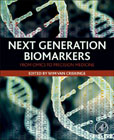
Next Generation Biomarkers: From Omics to Precision Medicine offers a clear methodology for successfully discovering and validating biomarkers using next generation sequencing, along with a comprehensive overview of next generation biomarkers currently used in the clinic. With recent advances in genomics and -omics approaches, elaborative molecular profiling is increasingly employed to gain fundamental insight into disease etiology and progression. Through a case-study based approach, the book examines a variety of NGS genomic and omics approaches to biomarker discovery and validation, along with lessons learned from recent studies and clinical trials. Chapters explore common challenges, regulations and strategies for more accurate and efficient development of next generation biomarkers for use in precision medicine. Other sections cover NGS approaches, ranging from whole exome sequencing, to whole genome sequencing, epigenomic profiling, transcriptomics, peptidomics, proteomics, liquid biopsy, ethical considerations, and patient empowerment in biomarker development. Establishes a clear methodology for successfully discovering and validating biomarkers using next generation sequencingProvides a comprehensive overview of next generation biomarkers currently used clinicallyExamines a variety of NGS approaches to biomarker identification, lessons learned from recent studies, common challenges, regulations, and strategies for more accurate and efficient identification of next generation biomarkers for use in precision medicineCovers NGS approaches, ranging from whole exome sequencing, to whole genome sequencing, epigenomic profiling, transcriptomics, peptidomics, proteomics, and liquid biopsy, as well as ethical considerations and patient empowerment in biomarker developmentFeatures contributions from leading international researchers working at the forefront of NGS biomarker discovery and validation INDICE: Section 1: Introduction 1. Scope 2. Biomarker is a biomarker is a biomarker 3. Omics 4. Precision medicine Section 2: Biomarker Development Path 5. Overview - clinical development path (analogy to Therapeutics) - Fit for purpose 6. Analytical Validation 7. Clinical Validation 8. Clinical Utility Section 3: Statistical Considerations 9. Introduction 10. Discovery Informatics / Machine Learning 11. Statistical Issues for Biomarker Studies (confounding, statistical tests, multiplicity/overfitting, FDR) 12. Statistical versus clinical significance 13. Biomarker study design (RCT, Biomarker by Treatment Interaction Design, Adaptive Designs) Section 4: Molecular Profiling The Sample: Diagnostic Matrices 14. FFPE 15. Liquid Biopsies 16. Extracellular vesicles The method: Technologies 17. PCR versus Sequencing: The Heisenberg Uncertainty The test 18. From Central Reference Labs over IVD kids to Sample to Anwers and Mobile Platforms Section 5: Clinical Biomarkers Genetic 19. Lessons learned 1 20. Lessons learned 2 21. Lessons learned 3 22. Whole genome-exome diagnostics Epigenetic 23. Lessons learned 1 24. Lessons learned 2 25. Whole epigenome / Methylation atlas Expression (RNA, miRNA, lncRNA) 26. Lessons learned 1 27. Lessons learned 2 28. Transcriptomics Translation (Protein) 29. Lessons learned 1 30. Lessons learned 2 31. Proteomics 32. Peptidomics Section 6: Clinico-Genomic 33. best of both worlds Section 7: The Economics of Molecular Diagnostics 34. HTA/Economic evaluation 35. Reimbursement 36. IP - Intellectual Property 37. Commercialization - Business Models - Translating biomarkers successfully to the clinic Section 8: Biomarkers and ELSI (Ethical, Legal and Social Implication) 38. Legal - Regulations 39. Ethical and Social Implications Section 9: Biomarkers and Patient Empowerment 40. Risk Management, A Review of Shared Decision-Making and/or Evidence-based advocacy Section 10: Best Practices 41. Keys to success/lessons learned
- ISBN: 978-0-12-814315-5
- Editorial: Academic Press
- Encuadernacion: Rústica
- Páginas: 400
- Fecha Publicación: 01/06/2018
- Nº Volúmenes: 1
- Idioma: Inglés
